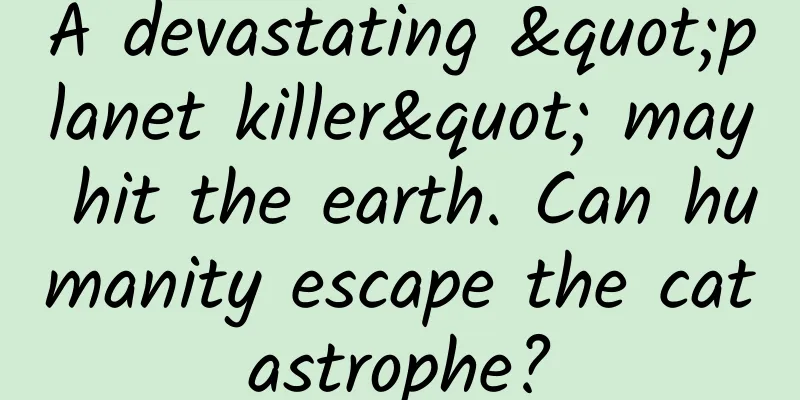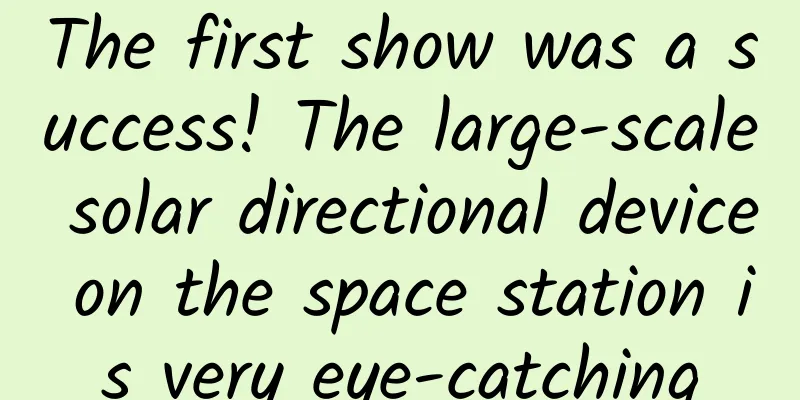A devastating "planet killer" may hit the earth. Can humanity escape the catastrophe?

|
Astronomers recently discovered a huge asteroid called 2022AP7, which is 1,500 meters in diameter. The orbit of this asteroid shuttles inside the Earth's orbit and intersects with the Earth's orbit. Astronomers call such a large asteroid a "planet killer". If it hits the Earth, it will cause a catastrophe of ecological extinction. These asteroids are difficult to detect because they are hidden in the direction of the sun within the Earth's orbit and the strong sunlight obscures their tracks. Huge and advanced telescopes such as the Hubble Telescope and the Webb Telescope must avoid the glare of the sun, otherwise their delicate optical systems will be damaged, so they cannot detect these asteroids. Astronomers used the Dark Energy Camera (DECam) installed on the Víctor M. Blanco 4-meter telescope at the Cerro Tololo Inter-American Observatory in Chile during a brief window of twilight to discover three asteroids in Earth's orbit. In addition to 2022AP7, the other two are numbered 2021LJ4 and 2021PH27, both of which are kilometers in size. The trajectories of the other two of the three asteroids intersect less frequently with the Earth, while 2022AP7 poses a significant threat to the Earth. When 2022AP7 was discovered, it was moving 30 million kilometers from Earth, which seems to be a safe distance. But after calculation, the trajectory of this asteroid will continue to approach the Earth in the future, and it is likely to have a close encounter with the Earth at some point in the future. The study was published in the Astronomical Journal on October 31. As for when 2022AP7 will come into contact with the Earth, astronomers are still unable to make a judgment, but it will not appear in 2022. Therefore, in the short term, concerns about 2022AP7 can be relieved and you can go to bed. But the problem is that astronomers always have this worry in mind. Because there are as many as 19,500 near-Earth asteroids discovered near the Earth, of which more than 2,000 have a diameter of more than 1 km and hundreds are 4 km. The orbits of these asteroids will intersect with the Earth's orbit, and any close contact with the Earth could bring about the extinction of mankind. So, how big a disaster would such a huge asteroid hit the earth cause? We can do a simple calculation. You know, 65 million years ago, a 10-kilometer asteroid hit the earth, causing the dinosaurs that dominated the earth for 165 million years to disappear, and 85% of species became extinct. This changed the evolutionary direction of the earth's ecology, and humans emerged from the rise of mammals. The asteroid only left a crater about 280 kilometers in diameter on the Yucatan Peninsula in Mexico, but its impact energy was about 120 trillion tons of TNT equivalent, equivalent to more than 10,000 times the total number of nuclear bombs in the world today. This huge force caused a thousand-meter tsunami, a global earthquake, and smoke and fire that covered the sky, which eventually led to the breakdown of the ecological chain and the extinction of a large number of organisms. 2022AP7 is much smaller than the asteroid that caused the extinction of the dinosaurs 65 million years ago, so its impact energy is naturally much smaller. Will it not have a big impact on the Earth's ecology? Let's simply speculate on the consequences of this impact and we will have a rough judgment. According to information disclosed by scientists, the orbital period of 2022AP7 (one revolution around the sun) is 1830 days (5.01 years), the aphelion is 5.01AU (astronomical unit, 1AU is about 150 million kilometers), and the perihelion is 0.83AU. It is an irregular long potato shape with a diameter of approximately 1.011 to 2.260 kilometers. Therefore, it is believed that the average diameter is about 1.5 kilometers, and its orbital motion speed is 17.38 kilometers per second. Although the report did not say whether this asteroid is a comet or solid rock, the possibility of it being a comet is extremely small. Therefore, based on these parameters, we assume that this asteroid is composed of rock with a density greater than that of a comet. The general rock density is 2 to 3 tons per cubic meter. We calculate it at 2 tons per cubic meter, so the mass of this asteroid with a diameter of 1.5 kilometers is about 3.5 billion tons. The orbital speed of 2022AP7 is 17.38 kilometers per second, but it will not be at this speed when it hits the Earth. Instead, it will be a superimposed speed with the Earth's orbital speed. Of course, it will not necessarily be a head-on collision, nor a rear-end collision. It is more likely to collide obliquely, so we assume that its speed of hitting the Earth is 20 kilometers per second. In this way, based on the impact energy formula E=1/2mv^2, we can simply calculate that the energy of 2022AP7 hitting the earth is about 7*10^20J, which is 7 trillion joules. This energy is equivalent to 16.73 billion tons of TNT equivalent, which is the power of about 12.87 million Hiroshima atomic bombs exploding at the same time. You should know that the total amount of nuclear warheads in the world is less than 10 billion tons of TNT equivalent. In this way, the power of 2022AP7 is equivalent to the power of all nuclear bombs in the world exploding 17 times. Some people say that the earth's nuclear weapons have been able to destroy the earth's ecology three times. If the world's nuclear warheads explode 17 times in succession, it is hard to predict whether humans can survive such a hellish destruction. Although this calculation is not very accurate, the impact energy will also change according to the impact speed and density of the asteroid. Some people believe that the energy of this asteroid is equivalent to 300 million atomic bombs. I don't know what parameters are used in this calculation, so I won't comment on it here. But historical experience and scientific research show that if an asteroid of tens of meters hits a densely populated area, it will destroy a city; if an asteroid of more than 100 meters hits a densely populated area, it may destroy a small country. If an asteroid of more than a thousand meters hits the earth, it is enough to bring devastating disasters to humans and the ecology. These disasters include: Huge tsunamis and earthquakes will hit the globe, and coastal cities may be completely submerged; flames and smoke will cover the sun, and those creatures that have managed to escape will suffer the consequences of a nuclear winter: all plants will lose photosynthesis and die, herbivores will become extinct first, followed by carnivores, and the food chain will be broken, leading to a mass extinction of species, even including microorganisms. Some people may think that humans may have a lot of high technology to save themselves. However, under the impact of a global disaster, the most developed coastal cities are all submerged, the global air is extremely polluted, and the lack of water, electricity and transportation makes all modern production and life unsustainable. The food chain caused by the nuclear winter has broken and caused a great famine. The lack of medical care and medicine has led to an uncontrollable plague. It is really hard to predict how many people can survive. Nuclear winter may not last too long, and the Earth's surface may see sunlight again in a few years or even a dozen years. But the Earth at that time is no longer the Earth we know, and the original species are basically extinct. It will take tens of thousands or even hundreds of millions of years for new life to evolve and prosper again. But how many humans will survive after the nuclear winter? How will they survive and reproduce in the desolate world after the nuclear winter? Everything that has been formed by modern means, including medical care, production, seeds, and living conditions, has been lost, and the environment can no longer provide everything people want like it does now. Therefore, some people say that the 10-kilometer asteroid 65 million years ago caused the extinction of dinosaurs, and the 1.5-kilometer asteroid may not cause the extinction of humans, but will only send humans back to the Stone Age. But I think the consequences may be far more than that. Perhaps human civilization will disappear from then on. After the life on Earth restarts, perhaps a new civilization will emerge, but I think there will be no place for humans by then. Based on this, humanity still has a long way to go in preventing the threat of asteroids. It is precisely because of the extreme harm of asteroids to humans that the world's scientific community has paid more and more attention to it. The United Nations has long established a special organization to study and respond to asteroid threats. In this cause that concerns the fate of mankind, NASA is undoubtedly at the forefront of the world. Not long ago, they conducted a groundbreaking experiment of historical significance, the Double Asteroid Redirection Experiment. The main content of the experiment is to launch a spacecraft nicknamed "Dart", aiming at a binary asteroid system called Ditimos in the deep space 10 million kilometers, and accurately hit the auxiliary star Dimophos, thereby changing its orbit and obtaining precious data that can be used to change the orbit of an asteroid to save mankind when it hits the earth in the future. This rescue experiment has epoch-making significance for future asteroid impacts on the Earth, but this experiment has just begun and is still aimed at very small asteroids. Ditimos is only 160 meters in diameter. If a 1,500-meter asteroid hits the Earth now, will NASA be able to change its orbit to avoid the Earth? I think it is still difficult to do, and it depends on how early the asteroid is discovered and how strong the impact is. For example, when people discovered 2022AP7, it was only 30 million kilometers away from us. If it hits the earth at a speed of 17.38 kilometers per second, we would have less than 20 days. In just 20 days, could people build a spacecraft, accurately calculate the impact location and force, or carry a huge nuclear bomb to hit the asteroid? It should be noted that the planning and development of the "Dart" mission took more than 10 years, and it took 10 months to launch and track the Didymos binary asteroid system before the shocking collision occurred. Therefore, there is still a long way to go to prevent asteroid impacts, but we must continue to do so and ultimately eliminate this threat so that humanity can have a chance to survive longer. Fortunately, scientific tracking has found that these asteroids that threaten the Earth, including 2022AP7, will not pose a major threat to the Earth in the short term, leaving more time for humans. We should cherish this time, unite and cooperate to develop science, and jointly respond to the major disasters that may be faced, so that humans can reproduce and thrive for a longer time. If you have any opinions on this, please feel free to discuss and comment. The original copyright of Space-Time Communication is reserved. Please do not infringe or plagiarize. Thank you for your understanding and support. |
>>: When brain-computer interfaces become a reality, how far are we from cyberpunk?
Recommend
After failure in India, Google's Android One is set to fail in Africa
In May 2014, Google launched the Android One proj...
Top 10 keywords for breaking through brand traffic in 2021!
As the consumption environment evolves, how can n...
GoPro's dilemma: competitors' pressure and slow content monetization
In 2004, based on his own interests and hobbies, ...
Is WeChat going to charge money? Two functions will be charged. Those who like to read subscription accounts and use red envelopes should pay attention.
Preface With the development of social economy, I...
California approves Google Waymo to transport passengers on driverless roads
In the wave of AIoT and 5G, autonomous driving ha...
Can a drug be used to “eliminate” bacteria at a specific point? Does such a drug really exist?
In our impression, viruses are often the source o...
Based on the current situation of the community, let’s talk about how we operate the community?
To operate a community well, the key is to find t...
Seeing a doctor, taking medicine, and joining a church: three logics of content payment today
Luo Pang said that content payment is far from be...
Unboxing the TD-LTE iPad Air
In terms of network support, the new 4G iPad suppo...
It turns out that the stomach is an emotional organ. There is an emotional line from the brain to the stomach.
Science Fiction Network, March 20 (Qin Yingying) ...
If you use your phone improperly, be careful that it will turn into a "grenade"! During the long holiday, let's talk about the issues of mobile phone charging
Qingming Festival Whether at home or traveling I ...
Tik Tok’s skills in riding on the popularity, how does Tik Tok ride on the popularity to exceed 10,000 views?
Tik Tok’s skills in riding on the popularity, how...
Heavy rain warning! Heavy to torrential rain in Guizhou and other 11 provinces and regions
The Central Meteorological Observatory continued ...
After reading this article, you can also pick up meteorites in the wild!
Although I have been doing meteorite research, Bu...
China Automobile Dealers Association: Auto dealer inventory coefficient is 1.35 in June 2023
On July 10, 2023, the China Automobile Dealers As...









